How do you protect wild places if you’ve never spent time in them? Without being exposed to nature, how do you foster a love for it? Those are two of my big concerns with the population at large as I get older. Backpacking with kids – specifically my two granddaughters that are 3 and 4 years old, is a way to show the next generation the magic in nature-filled wild places that most people will never see. Going forward, I plan to do an annual trip with them.
My granddaughters know me well from numerous sleepovers, sometimes for days at a time, and plenty of trips to neighbourhood parks. Now that diapers are a non-issue, I felt it was time to have a backpacking adventure in the great outdoors.
Back in March I booked a backcountry campsite at Elbow Lake in Alberta’s Kananaskis Country – but only for one night. I wanted our first backpacking trip to be successful and how much can go wrong in just 24 hours?
I know the Elbow Lake area well – and even though the approach to the lake is steep, it’s also short. The lake too is a beauty – which may be lost on the kids but counted a lot for me and my husband.
I also figured between he and I, we could haul their knapsacks and even carry one of them if it came down to that. Let’s just say that the backpacking trip with the kids was a rousing success until midnight. Then things went south as you’ll discover if you keep reading.
This post includes some affiliate links. If you make a qualifying purchase through one of these links, I will receive a small percentage of the sale at no extra cost to you. Thank you very much for your support.
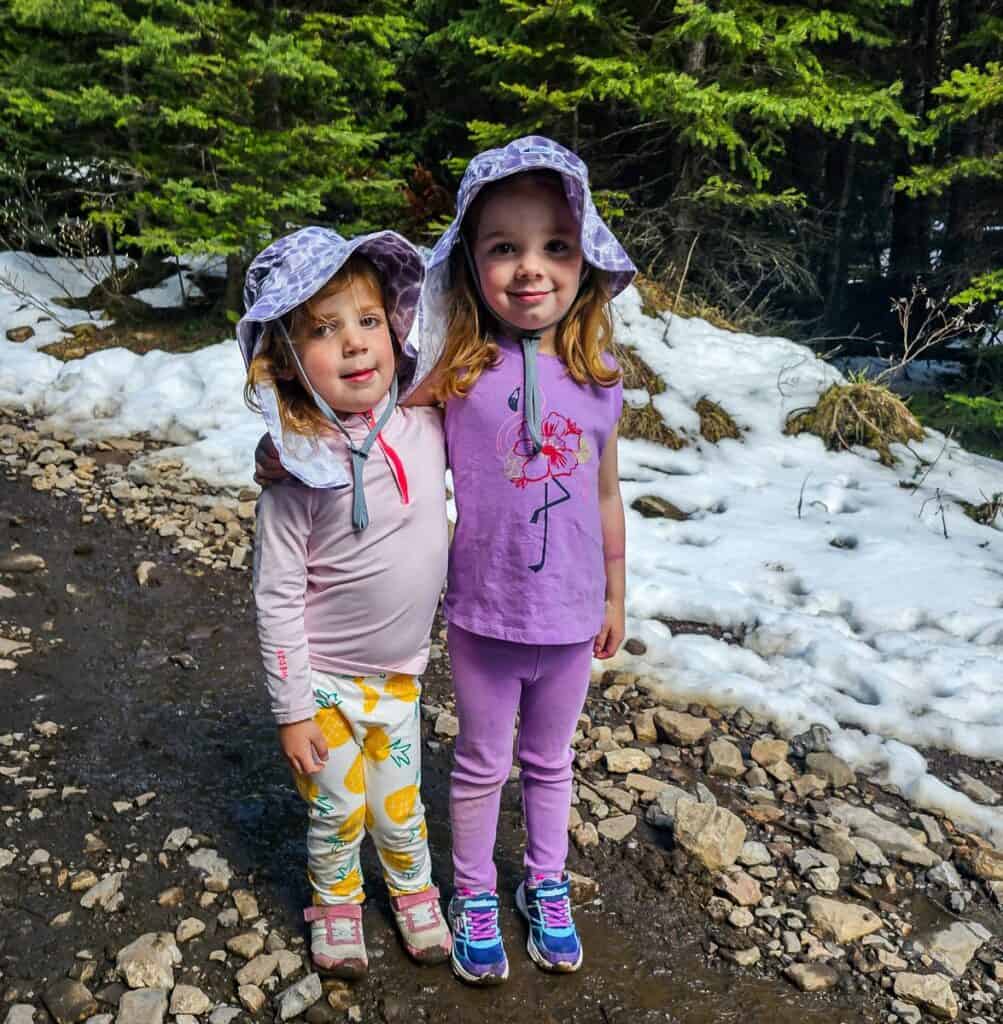
Preparation and planning a backpacking trip with young kids
There’s as much preparation and planning for a one-night backpacking trip with young kids as there is for John and I heading out for days at a time. Their mother, my daughter, had done a lot of the work – including packing clothes, treats, and talking to them about the trip, so that they were upbeat and excited about it. But there was plenty to do on our end too.
I don’t want to come across as preachy because I learned a few things on this trip too, but I think many of you – especially if you’re a new camper or a grandparent out of practice backpacking with young kids – you’ll find at least some of these tips to be useful.


1. How do you choose a kid-friendly backpacking trip?
If you’re a regular backpacker and camper, then you already have a pretty good idea of how much work it is to carry all your gear and food on your back.
With that in mind, I opted for a short hike to a beautiful campsite. Ideally, there should be firepits in case the temperature plummets and just because it’s more fun. It’s also a good way to meet other families and hikers.
If you don’t know where to start, look to family camping and outdoor blogs in your part of the world. Don’t be afraid to send a message and ask for their advice.
A couple of recommendations in Alberta and eastern BC for backpacking with kids include the Elk Lakes hike coming in from Sparwood (no reservations needed), Takkakaw Falls campground in Yoho National Park (reservations now needed), and Point Campground (reservations needed) on Upper Kananaskis Lake if you think your young kids can walk 3.4 km one way.
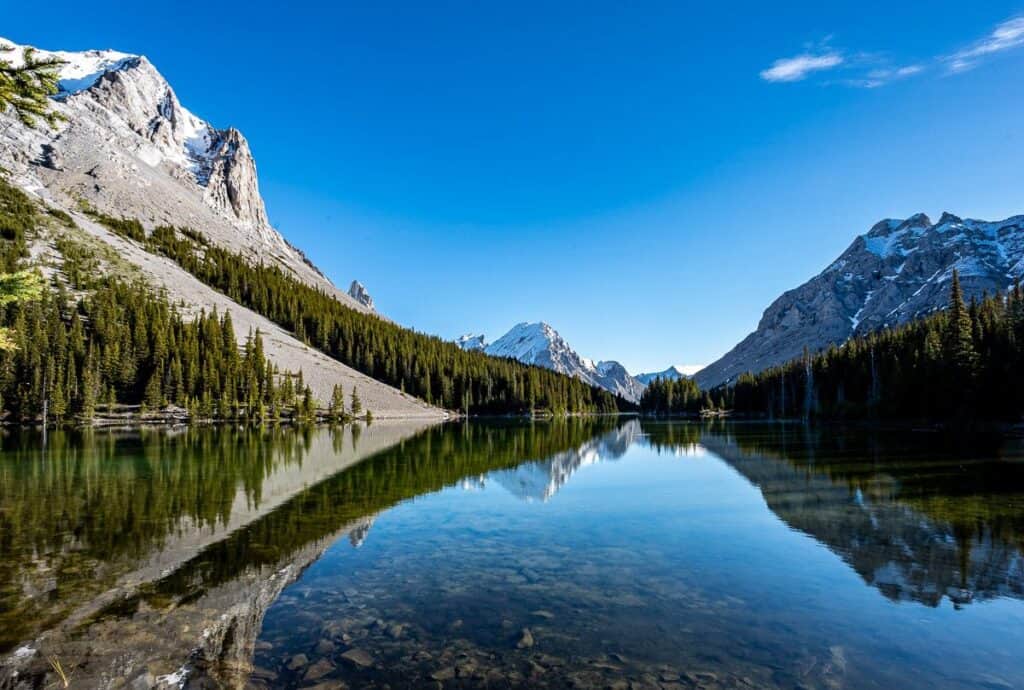

2. How far can you reasonably expect young kids to backpack?
Active young kids should have no problem backpacking 5 – 8 km if it isn’t too steep. But that’s going to depend a lot on how often you as a family are outdoors being active. Of course, the older they are, the farther they should be able to hike and the more they can carry. Start off with an easy backpacking trip with your kids or grandkids to work out the kinks.
When we lived in Colorado, I met a mom on a hike with her 4-year-old son who was working his way through all the 14,000 foot peaks. This 4-year-old in New Hampshire just finished climbing all forty eight 4,000-foot peaks, so with a little training I think you may be shocked at how far little legs can go.


3. What safety precautions you should take?
In the Rockies, cold water, snow and bears are big concerns. In other parts of the world, it may be heat and staying hydrated.
Bears
I knew the trail to Elbow Lake was a popular one, so even though this is grizzly bear country (we saw one along Highway 40), I didn’t expect to run into a bear. Still, John and I had bear spray readily accessible – which we kept out of reach of the children.
I didn’t want them to be thinking of bears as they fell asleep – as I know they both have very active imaginations. As your kids get a little older, they should be taught all the bear safety tips.
There are bear lockers at Elbow Lake – and we did get the kids involved in trips to put our food and toiletries away.
Cold water
When you’re camping beside a lake, especially a cold alpine lake, you need to be vigilant. I didn’t want to turn my back for one second. And we never did. Fortunately, they were just as interested in all the stuff you find in the forest.
Snow
I didn’t expect to encounter as much snow as we did the third week of June – but it had been a very cold spring in Calgary. A few years back, John and I had camped at the Tombstone Campground – the next one you reach after Elbow Lake. We’d hiked Piper Pass and Rae Lake, and both were completely snow free. Not this year!
As we approached Elbow Lake there was more and more snow along the trail. We were lucky to keep the kid’s shoes dry but made the mistake of putting their Crocs on in camp. They promptly froze their feet and needed multiple changes of socks. The bottom line – carry more warm socks than you think you’d need.
Gear and equipment for a backpacking trip with young kids
1. What type of backpack is suitable for young kids?
Choose a backpack that fits their small bodies. If it’s too big, you’ll end up carrying it.
The one we used – theHerschel Heritage Backpack– worked very well. It was large enough to fit most of their clothes (we carried their winter coats and mitts), their blankets, stuffed animal, and a Robert Munsch mini book each.
Our older granddaughter carried her backpack for all but 150 m around a muddy stretch. Our younger granddaughter carried hers for about a third of the way. Both kids did better than I expected for their first backpacking trip.
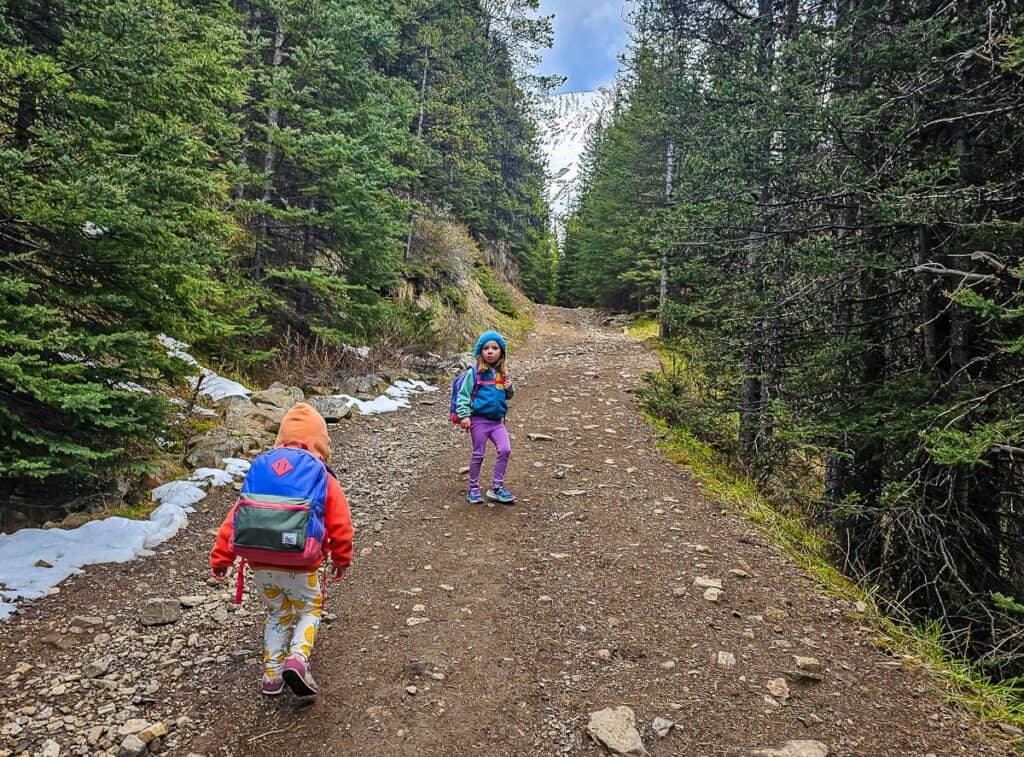

2. What kind of sleeping gear is best for young kids?
Your kids and grandkids need the same warmth of sleeping bag as you do. A warm bag can make or break a backpacking trip on a cold night – and it dipped down to freezing for us.
We used theMEC Draco Jr-5 down sleeping bag– and I’m so glad we had it. It was cozy, but not so tight fitting that they couldn’t move around. It packed into a reasonable size and weighs just 453 grams.
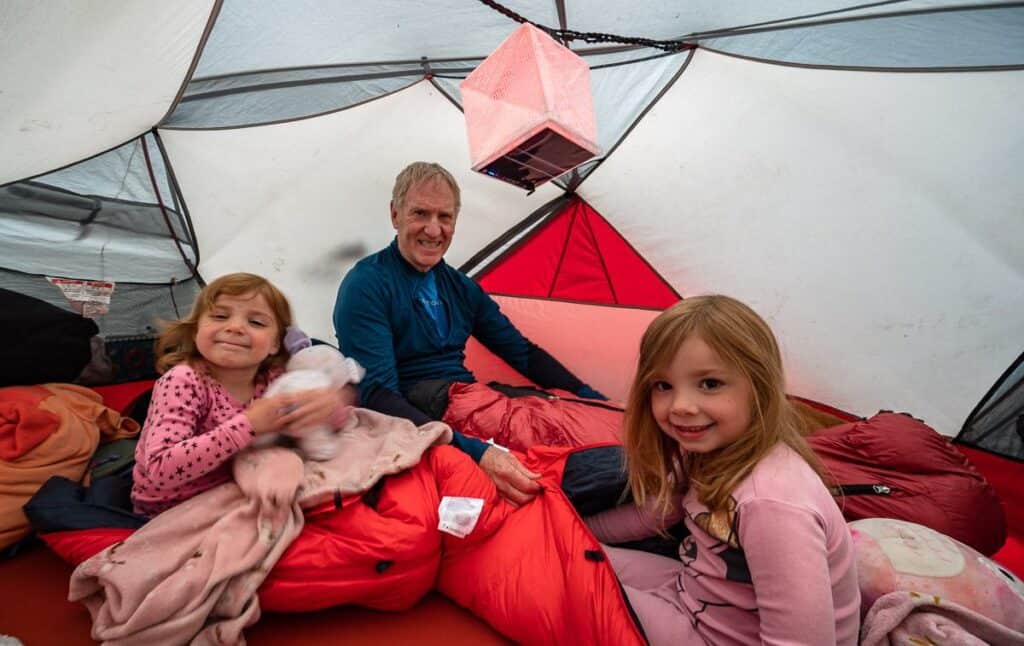

3. What kind of clothing should we pack?
We packed for warm, cold, and wet weather. In the end we could have left the short-sleeved t-shirts and shorts at home – but at their age, they hardly take up any room.
Their mom had packed a long-sleeved warm top and leggings which they lived in. When it started to cool down, we added the fleeceFireside Hooded Jacket– which is cozy with pockets and a hood. When the temperature dropped further, we added their winter coats. A warm hat and good mitts are a must too when backpacking with kids (and adults too).
I think an investment in a kid’sdown jacketthat stuffs into nothing would be the way to go if you planned to backpack a lot, especially in the mountains.
We packed theMEC Aquanator Jacketin case it rained, though we didn’t end up needing it on this trip. Still, it didn’t take up a lot of room and it could do double duty as a wind breaker.
For a sun hat you can’t beat theSuperhero sun hatwith a removeable neck cape. This one is lightweight and well-designed.
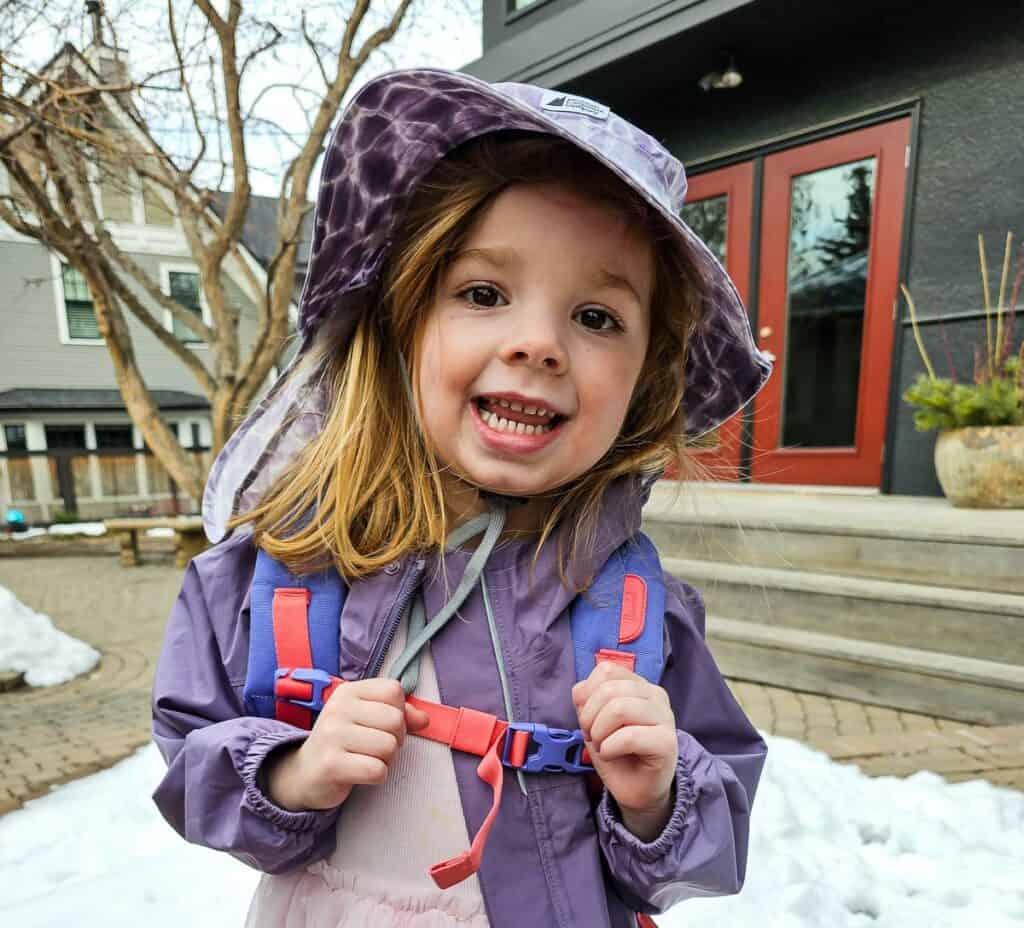

4. What kind of tent is best with young kids?
We have a3-person MSR Elixir tent(weighing 3.2 kg) which we love – and have used multiple times a summer for at least five years now. However, if I was to do this trip again – and considering we have a 50-pound dog, I would invest in the4-person MSR Elixir tent(weighing 4.3 kg) to give us all a little more breathing room.
I think a tent with two doors is key when you have four people – especially if you must get up in the middle of the night – which we did multiple times.


5. What kind of food and snacks should we bring backpacking with kids?
Food turned out to be a big issue. Their mom had packed snacks and we’d decided ahead of time on meals that we knew they liked. But kids are fickle and will change their minds in a heartbeat. What is popular one day is not the next.
Dinner worked out fine, but breakfast did not. I had brought my homemade pancake mix and maple syrup…and oatmeal as a backup. We weren’t up to pancakes at that point (see below) – though our youngest granddaughter still figured we should be short order cooks. In hindsight, I wish I’d packed more fresh fruit, and dry cereals I knew they liked.
Part of the problem was my oldest granddaughter had projectile vomited onto me, my sleeping bag, her blanket, and anything else in the way around midnight. We didn’t see that one coming. In the future I will have wet wipes in a plastic bag handy in case of any incidents in the tent. We cleaned up as best we could and 15 minutes later, she vomited again. And then four more times over the next two hours – another great reason for having a two-door tent. By the end of the night, we all smelled like vomit – and the only thing John and I really needed was coffee. I’m sure our youngest granddaughter would have been fine if I whipped up pancakes, but I think you can see why I didn’t.
Health and safety on a backpacking trip
1. How do we handle a backcountry medical emergency?
The beauty of choosing a campsite that is a short walk away from the parking lot is that you can get back to it quickly – and then drive to the nearest hospital.
But that’s not always going to be the case. It’s helpful if you have some medical knowledge and have taken a basic first aid course.
If you’re in a campground with other people, I’d raise the alarm that you have a medical emergency and see if there is a nurse or doctor that could help.
Beyond that, pack yourGarmin inReach Mini2and send an SOS. How long they take to get to you will be a function of how remote you are. Hopefully, it never comes down to that.
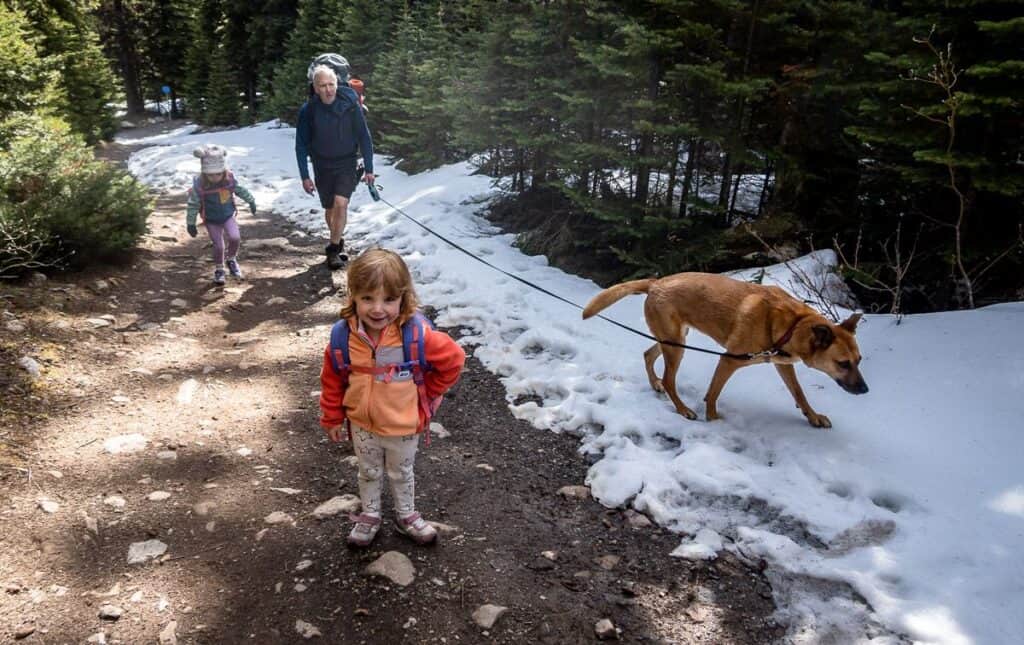

2. What should you include in a first-aid kit for young kids?
We packed our usual first-aid kit with Band-Aids, sterile pads, Polysporin and the like. But with the kids we included kid’s Tylenol, Advil, and Claritin in case of allergies.
3. How do you deal with bathroom needs with young kids in the backcountry?
This too was an issue and I totally get it. When I took my older granddaughter to the outhouse (clean, new and non-smelly) and we got inside, she took one look at the large drop from the toilet to the pile of poop – and said, “I don’t need to go.” It looks scary from a kid’s perspective.
I think we should have talked about how to pee and poo ahead of time. They ended up peeing in the woods and I followed up with hand sanitizer. Toilet paper was packed out. Not ideal but we will do better next time.
4. How do you keep young kids hydrated?
We brought the water bottles they were used to using at home and that worked well. They can be sipped in the tent without spilling.
5. What are the best ways to protect young kids from bugs and wildlife?
It was too cold to have to worry about bugs – but I would recommend carrying insect repellent. Use judiciously.
I think adults are more often the problem than kids. A few bugs aren’t going to hurt anyone, though I’ve seen enough adults go crazy with just a mosquito or two. If it’s a bad bug night and you can make a campfire, do it, as smoke will keep bugs away.
When it comes to wildlife, education is key. It wasn’t an issue on our backpacking trip but kids should be taught to respect wildlife, give them space – and certainly never to feed them.


Entertainment and comfort
1. How do you keep young kids entertained on a backpacking trip?
The outdoors provides most of the entertainment you need. However, we found they needed a distraction while we got everything set up and organized and when cooking meals. Their mom had once again come to the rescue and packed markers and notebooks for both of them. They were thrilled.
I had incorrectly assumed there would be a picnic table by our campsite. But there was not, so once the tent was up, we put them inside and brought out the markers so we could get the rest of the camp chores done in peace. That worked well.
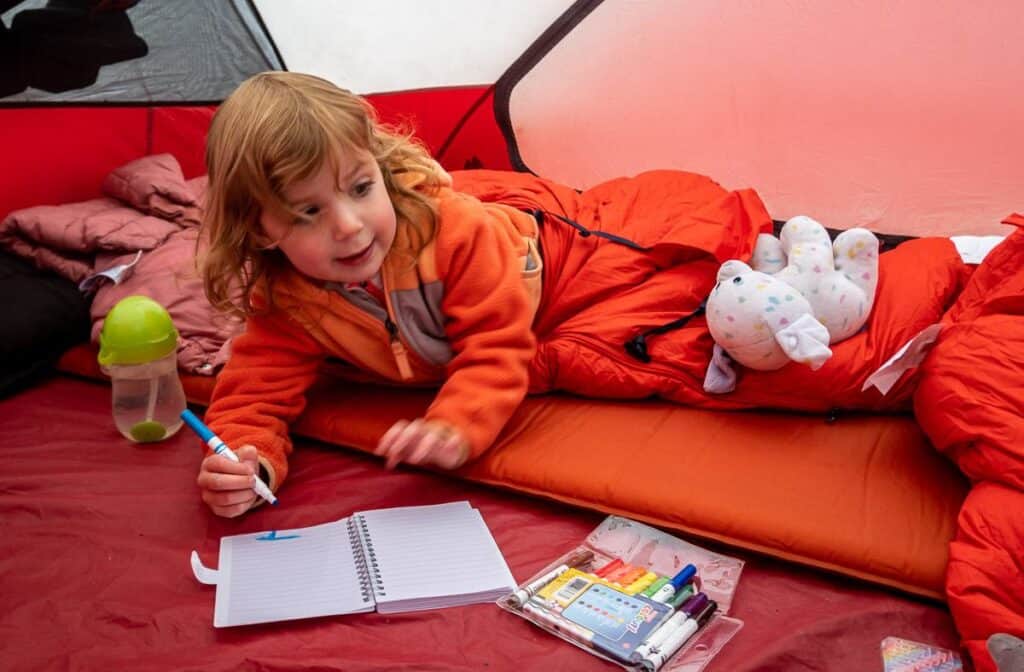

2. How do you motivate young kids on a backpacking trip?
Bribery. Sugar. But don’t promise what you can’t deliver.
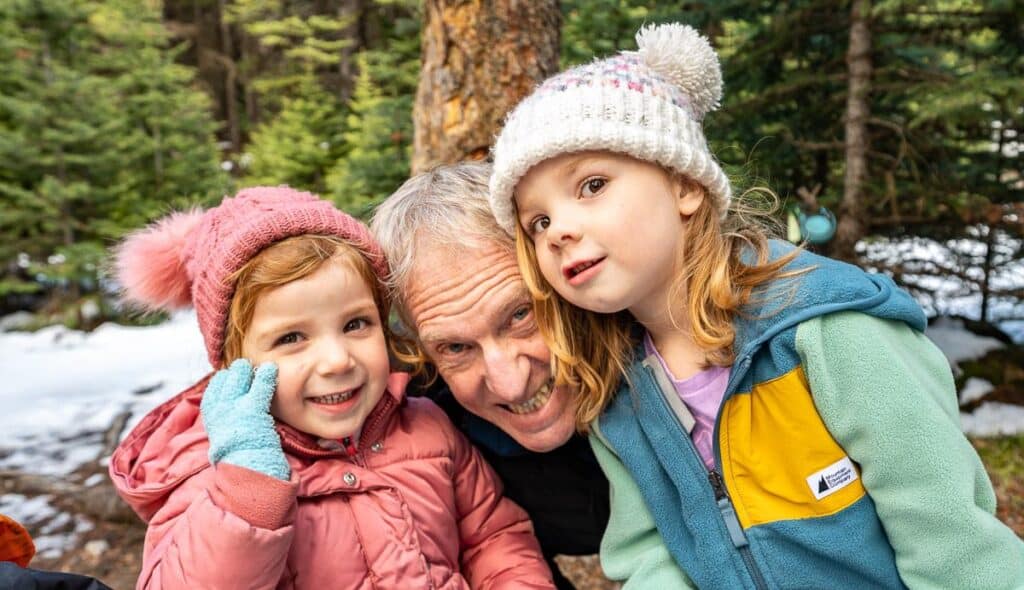

3. How do you deal with new sounds or fears at night?
We had airplanes flying over numerous times at night and they sounded close and quite scary. The kids looked to us for reassurance and that was the end of the issue. I really didn’t want to go down any path that fueled their imagination, so we kept it light.
4. How can you share some of the fun aspects of nature?
Birds, wildflowers, running water, rocks, moss, trees – you name it – all are great for learning about nature.
There are apps – like iNaturalist – that would be useful for you as an adult for plant and animal identification. The kids then can become citizen scientists and feel proud with the finds they make.
My husband is a huge fan of the Merlin app – used for identifying bird sounds. That too is a great way of turning kids onto birding and putting the song and the bird together in a fun way.
I think looking for colourful rocks, which is never boring, and having their geologist grandfather share its history will be a lot of fun as they get a little bit older.
1. What kind of meals and snacks should you take on a backpacking trip with kids?
My daughter pulled together a treat bag – with a mix of healthy food and real treats like a Kinder egg. I used to do that on long backpacking trips with my own kids and they loved it.
2. How do you prepare the kids for the backpacking trip?
Set expectations and don’t build the backpacking trip into something it can’t be. Focus on how much fun the kids will have playing outside and being together as a family.
Foreworn them of things that will be new to them. I should have done a better job on the bathroom situation.
3. Should you teach Leave No Trace principles to young kids?
The sooner the kids learn that nature and the environment need to be protected, the better. Many of the Leave No Trace principles like leave what you find, respect wildlife, and be considerate of others are easy to explain to young kids on a backpacking trip.
As they get older involve them with the planning process, and teach them to take responsibility for their actions outdoors – and what happens when they don’t.
4. How do you set up and break down camp efficiently with young kids?
Get the kids involved right off the bat. We showed our granddaughters how to put up the tent and had them – with a little help, attach the tent to the poles. They were in charge of carrying some of the utensils and food to the bear box – so little by little we will have them do more.


More things to take on backpacking trips with young kids
You’ll needsunscreenandinsect repellenton many of the hikes in summer.
I suggest carrying agear repair patch kitin case anything ever goes wrong with your tent, sleeping mat, coat, etc.
Don’t forget asun hat with a brimand abandanathat you can soak in cold water to cool off.
Carry waterpurifying tabletsand if you’re with a group consider having someone carry agravity water filter.
A big thank you to MEC for providing the kid’s sleeping bags, backpacks, raincoats, sun hats and fleeces. After testing all products, I would highly recommend all of them.
More ideas for easy backpacking trips with youngish kids
Build on the easy ones, increasing the difficulty over time.
Click on the photo to bookmark to your Pinterest boards.












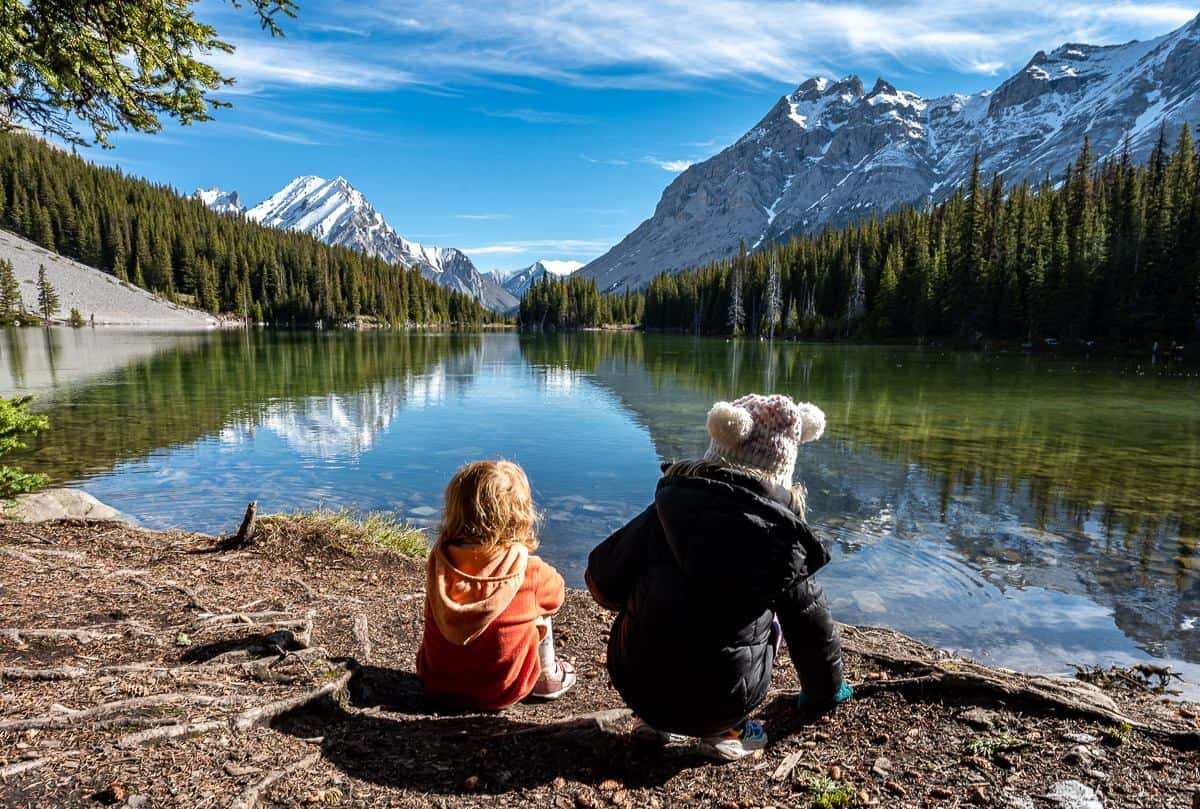




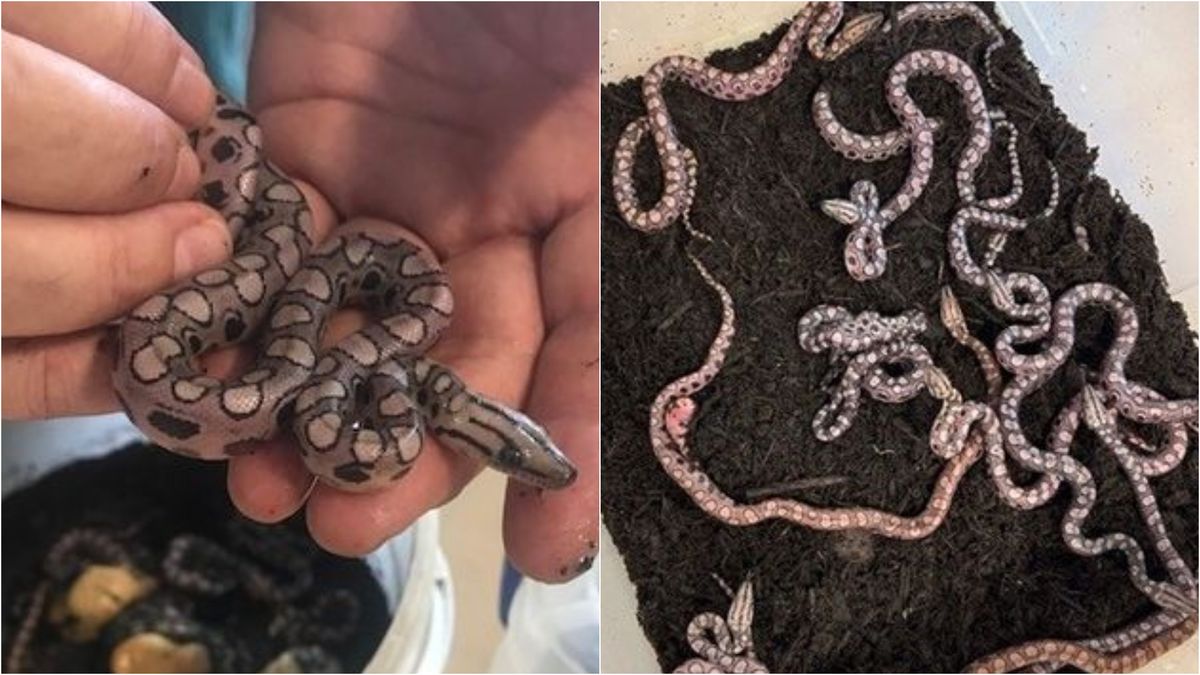





Discussion about this post